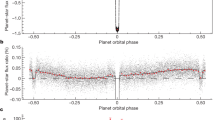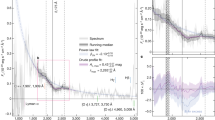Abstract
AN accurate extinction curve with a standard error of ± 0.008m which has been derived for a region in the direction of Cygnus (looking along the spiral arm) from spectrophotometric observations at the Royal Observatory, Edinburgh1, shows a pronounced discontinuity in slope at 4300 Å. This feature as well as recent rocket observations2 rule out the possibility that the interstellar dust is made up of iron or ice particles. Hoyle and Wickramasinghe3 have suggested that graphite particles, formed on the surface of carbon stars, could be ejected into interstellar space by radiation pressure, and Wickramasinghe4 finds that such carbon particles may become covered with ice mantles. The wave-length 4300 Å is close to that at which the refractive index of graphite particles begins to change, the extinction of graphite being remarkably close to a 1/λ law in the region 0.8 ⩽ λ−1 ⩽ 2.3 and thereafter deviating from such a law more or less according to particle size5. Nandy and Wickramasinghe6 have shown that the observed extinction curve for Cygnus can be well reproduced by the assumption of graphite cores with radii less than ∼ 0.06μ covered with ice mantles.
This is a preview of subscription content, access via your institution
Access options
Subscribe to this journal
Receive 51 print issues and online access
$199.00 per year
only $3.90 per issue
Buy this article
- Purchase on Springer Link
- Instant access to full article PDF
Prices may be subject to local taxes which are calculated during checkout
Similar content being viewed by others
References
Nandy, K., Publ. Roy. Obs. Edin., 3, 142 (1964).
Boggess, A., and Borgman, J., Astrophys. J., 140, 1636 (1964).
Hoyle, F., and Wickramasinghe, N. C., Mon. Not. Roy. Astro. Soc., 124, 417 (1962).
Wickramasinghe, N. C., Mon. Not. Roy. Astro. Soc., 129 (in the press).
Wickramasinghe, N. C., and Guillaume, C., Nature, 207, 366 (1965).
Nandy, K., and Wickramasinghe, N. C., Publ. Roy. Obs. Edin., 5 (in the press).
Nandy, K., Publ. Roy. Obs. Edin., 5 (in the press).
Greenberg, J. M., and Meltzer, A. S., Astrophys. J., 132, 667 (1960).
Wilson, R., Mon. Not. Roy. Astro. Soc., 120, 51 (1960).
Underhill, A. B., and Walker, G. H., Mon. Not. Roy. Astro. Soc. (in the press).
Johnson, H. L., Astrophys. J., 141, 923 (1965).
Mendoza, V. E. E., Tonantzintla y Tacubaya, 4, No. 26 (1965).
Guthrie, B. N. G. (personal communication).
Author information
Authors and Affiliations
Rights and permissions
About this article
Cite this article
NANDY, K. Interstellar Obscuration. Nature 208, 274–275 (1965). https://doi.org/10.1038/208274a0
Issue Date:
DOI: https://doi.org/10.1038/208274a0
This article is cited by
-
Impact of Distance Determinations on Galactic Structure. I. Young and Intermediate-Age Tracers
Space Science Reviews (2018)
-
Origin of the Diffuse Interstellar Bands
Nature (1968)
-
Unified Model for Interstellar Extinction and Polarization
Nature (1967)
Comments
By submitting a comment you agree to abide by our Terms and Community Guidelines. If you find something abusive or that does not comply with our terms or guidelines please flag it as inappropriate.



